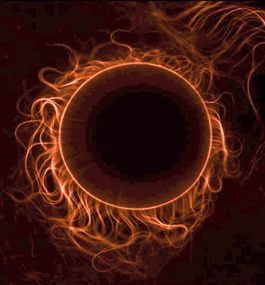A Matter of Fact (and Magic)

Courtesy Zvonimir Dogic
Oscillating microtubules
by Leah Burrows
Ever wonder how a flock of birds performs its choreographed dance across the sky? How fish swim in perfect unison? Or, for that matter, how thousands of cars, trucks, motorcycles and bicycles flow smoothly through a metropolis like Ho Chi Minh City, without traffic lights, stop signs or traffic cops?
Physicists have a term for objects — animate or inanimate — that exhibit self-organization or coordinated behavior. They are “systems of active matter,” and, on a large scale, they can be flocks of birds, schools of fish, gaggles of geese or crowds of humans — any sort of group that moves and organizes itself.
Now Zvonimir Dogic, associate professor of physics, aided by a team of postdoctoral fellows, graduate students and undergraduates, is attempting to discover the physical rules that govern microscopic systems of active matter.
The research could lead to countless improvements in many industries, from the development of drug delivery systems and microrobotics, to architectural designs for stadiums that reduce the possibility of fatal stampedes.
Recently, Dogic’s lab designed an active matter system by bundling together hollow biological structures called microtubules and propelling them with kinesin motor proteins. The proteins walk along the microtubules on two leg-like structures, sliding one microtubule filament away from another. The bundles move together in one direction, then another.
If the self-propelled bundles are inserted inside a droplet of oil in water, the microtubules begin to propel the droplet. In a group, the droplets move clumsily, constantly bumping into each other. They display no discernible pattern.
Yet, the same physical rules governing these droplets may also govern schools of fish. “What are birds or fish if not self-propelled creatures?” asks Stephen DeCamp, a graduate student in Dogic’s lab.
“The laws are universal,” DeCamp says.“The rules of flocking behavior might be fundamental to governing any self-organized system, from bacteria to fish to humans.”
Of course, the droplets are much simpler than birds or fish, containing only microtubules, kinesin proteins and a depletion agent to keep the bundles together. This simplicity allows the lab to experiment with the system, to figure out how these small active-matter particles may eventually work together to create a mesmerizing, magical moment in nature when synchrony rules.
